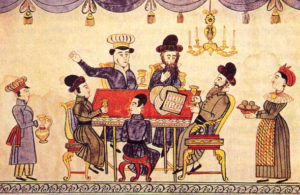When I was in my twenties, a couple I thought of as “older” invited me to go with them to a Passover seder in nearby Philadelphia. I was lonely and newly separated, and would have followed them anywhere. After we left the highway, the surroundings were ever more sinister as we drove into the heart of the city – darker, more graffiti, more empty streets. After what seemed like miles of incorrect turns, we arrived at a small rowhouse in a working class neighborhood on a raw, blustery night.

A 19th Century Seder portrayed in a folk print
The door could barely be opened, because card tables covered with snowy tablecloths filled the length of the modest living room. The steam of chicken soup and the sound of laughter warmed me up immediately. Our host, a short, smiling man dressed to the nines, welcomed us like a king to his castle. His plump wife smiled and nodded as she labored in the open kitchen, no bigger than a coat closet.
In my own family of three, the presence of even a guest or two was cause for alarm. My mother went into full scale panic at any number greater than five, and while it usually went well in the end, her hysterics along the way were inevitable and unbearable. And it had to be done on a budget, of course. My mother was generous but very careful. No penny was ever spent today that could be saved for tomorrow, in her framework of Protestant genteel poverty.
It was easy to see that my Philadelphia hosts didn’t have a lot of money. Their home was well kept but very simple. And yet, instead of buying a new fridge or better winter coats, they were feeding thirty people more courses than I’d ever seen before at a single meal. I’d been concerned about whether I would be comfortable among people who knew each other and the ritual. Instead, the host explained that, as a stranger, I had an important role to play. It was part of the tradition to include someone like me. For the first time, being someone on the fringe was validated and special, not a curse.
As the Passover ritual unfolded, I found myself strangely at home. Here, at last, I was among people to whom everything was meaningful, and symbolic. The bone wasn’t just a bone; it was a reminder of the sacrifice that was part of the original proceeding. Even the delicious combination of chopped apple and walnut and wine stood for something else: the mortar with which the Jewish slaves made Pharoah’s buildings. I was with people to whom the past was present and important, people who evoked that past poetically and symbolically.
The holy words resonated, too, even when I didn’t share the specific beliefs. When I heard about the four different children (wise, wicked, simple, ignorant) and their responses to Passover, I recognized the wisdom of the tradition to which I was being introduced. The evening went on and on, with every page getting its due, the children whizzing about to search for the hidden bit of matzoh, and more food appearing even when I thought I absolutely could not eat another bite.
I learned what “L’chaim!” “To life!” really means that night. I’ve been to many other seders, more in keeping with my own and my friends’ beliefs. I’ve read the questions in many contexts, from tiny formal groups to massive and rollicking ones. I’ve been able to give the proud answer “Lots!” to the question, “How much experience do you have making tzimmes?”
Still, my first seder was the best, the one where I learned the most, from the sumptuous offering of simple people to a complete stranger who will never forget them.

Hi Mary! I like this article! I attended a Seder once and hope to again. I also loved the symbolism and importance of the history.
Will you send me your blog?
Thanks! amy